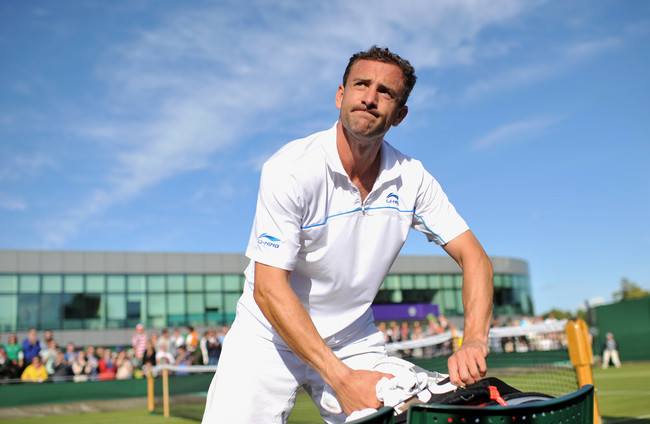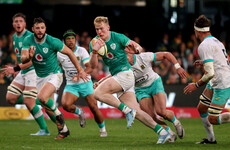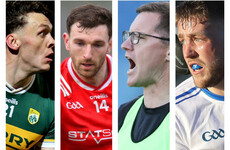THE FOLLOWING PASSAGE is an extract from The Racket by Conor Niland.
At 24 I was getting too old to be learning, but I was learning nonetheless, partly by getting to see true professional players up close.
I remember their wedding rings and their varicose veins: here were guys who travelled with wives and kids, grown-up players who had responsibilities, needing to make a living out of the sport, far removed from the immaturity of the Futures.
I was getting closer to the better players, but I wasn’t yet among them. I ended 2006 by travelling with the AAA- Team (Alan, Alex and Aubrey) to Tampa, Florida for a pre-season training camp at Saddlebrook. Saddlebrook had a serene atmosphere and seemed to be preferred by seasoned American male pros over the high-octane youthful environment of Bollettieri’s.
There was a large, international airport nearby and quiet, air-conditioned restaurants with extensive wine lists. Fine homes were available to rent or buy overlooking the campus’s manicured central golf course. There was a lovely, perpetually empty swimming pool and bar, tended to by bored-looking staff. Saddlebrook was perfect — if you had already made it.
As a squad, we drilled together daily. Bogdanovic was heavily backed by the LTA and had access that Alan and I didn’t. They were throwing cash at prospects that might take up position in the world’s top 50, and Bogdanovic was certainly in with a shout of achieving that.
A busload of British 13-year-olds showed up at the facility to train for a few days with coaches and physical trainers before playing the Orange Bowl, and the LTA had arranged personal training sessions for Alex with a renowned physical trainer, Pat Etcheberry.
I wasn’t invited to these sessions, so while Etcheberry put Alex through his paces using a medicine ball, ropes and a plethora of gleaming equipment, I looked on from the grass, stretching alone and running laps of the perimeter.
The LTA also had Agassi’s former coach, Brad Gilbert, on retainer, so he was available on the other end of the phone if Alex ever needed advice.
American top-teners James Blake, John Isner and Mardy Fish lived nearby and were working out at Saddlebrook when we were there.
Their court always appeared off-limits. They’d turn up in their Porsches, do their sessions together, then hop back in the Porsches.
They never spoke to me and I never spoke to them. I knew I was never going to get a chance to hit with them.
James Blake was in the world’s top 10, whereas I was ranked just inside the top 500. There was an ocean between us, and Blake didn’t need to build a bridge.
The greats in tennis often become known by their first names — Roger, Rafa, Serena — but the rest of us are known by a number, our world ranking.
To a greater extent than in any other sport, world ranking determines who you play, where you play and how much money you make. Tennis players have a deep and lasting relationship with their highest ranking.
Your ranking determined your social status on tour. The guy ranked at number 90 in the world doesn’t get as warm a handshake from the Slam champion as the guy ranked at 20.
The Williams sisters didn’t linger to have a chat with me at Bollettieri’s, but a girl I hit with who was ranked 50 in the world did stop and talk. Where a player sits in the hierarchy determines how they act, and everyone knows it.
At a later Challenger event in Marburg, Germany, a then 18-year-old Grigor Dimitrov was new to the men’s tour and latched onto me before the delayed arrival of his coach. He knew that I was also travelling alone, and he rang my hotel room a few times.
“Hey, wanna grab a pizza?” He was cocky, but friendly, and he knew he needed to earn his stripes at the Challengers. I liked him. He had won Junior Wimbledon and US Open Juniors the year before, and did not know many of the senior players.
“I like watches and speak English perfect,” he told me with a huge grin. I chose not to correct him, remembering my Bulgarian was sketchy. He also confided, even more proudly, that “Sharapova likes me, man.”
We practised together for the week. “Hey,” he shouted to me across the court during one hit, his eyes smiling.
He went into an impression of my stiff-looking walk, then picked up two balls and did an impression of my serve. It was very accurate. And funny. Professional tennis players are usually very good physical mimics. It’s how they got good in the first place, by copying what they saw on TV and processing physical cues from their opponents.
And Dimitrov, a world-class talent, was really good at it. They called him ‘Baby Fed’, because his style was nearly identical to Federer’s. I laughed back to him across the court, but suddenly felt my age.
Several years later, I watched Sharapova, now officially his girlfriend, cheering him on courtside at Wimbledon. I bumped into him occasionally, but his greeting to me became less and less effusive as his ranking climbed higher.
By the time he had cracked the top 20, he was ignoring me completely.
The Racket by Conor Niland is published by Sandycove, an imprint of Penguin Books. More info here: https://linktr.ee/conorniland












No interest in the game now but was a Newcastle fan at the time and have to say it’s hilarious to hear Shearer say that as you could practically see him shaking when Keane squared up to him.
@Guybrush Threepwood: Fun times
its boring now
@Anton Friendo: Yeah that type of game died out in the absence of the likes of Keane, Gatusso, De Jong etc. unfortunately..
@Guybrush Threepwood: It was the norm in school to support English soccer. Enlightenment happens only when you leave the education system.
If you read craig bellamys autobiography, he played in that game , he said Shearer was the last one off the pitch at the end of the game because he knew Keane was waiting for him
@Niall Browne: Bellamy is going to say that isn’t he? Seeing as Shearer battered him in Dawson St when they were over here. Bad mouthed him too when he thought a transfer away from St James Park was happening. Nearly shit himself when it fell through and he had to show up there for training.
@Gerry Ivie: it was Keith Gillespie that Shearer punched in Dublin.
Probably a lot bias here. Both great players and true warriors representing their respective teams. Love Keane but also like Shearer for being a great number 9. Hope Kane breaks his record though!
Grown ups arguing about one man’s ability to beat up another when the know neither and have never seen either actually fight.
The level of cringe is spine tingling.
@Gustave H: I don’t think anyone is arguing here. Everyone seems to be in agreement that Shearer looked genuinely afraid of Keane during that particular confrontation. Which was understandable to an extent, because Keane’s lack of self control and reckless abandon was rarely more evident than during that game.
Funny considering that you could visibly see the point when Shearer sh*t himself at the time
You wouldn’t have had it in you Alan. Stick to throwing balls at him from a safe distance you coward.
@Stonerpug: it was Keane who threw the ball as well as the punch. Shearer did the smart thing and stood there while Roy had a meltdown and got himself sent off in the last minute for no reason.
@The Bloody Nine: You are 100% Correct.Shearer was too smart for that nonsense